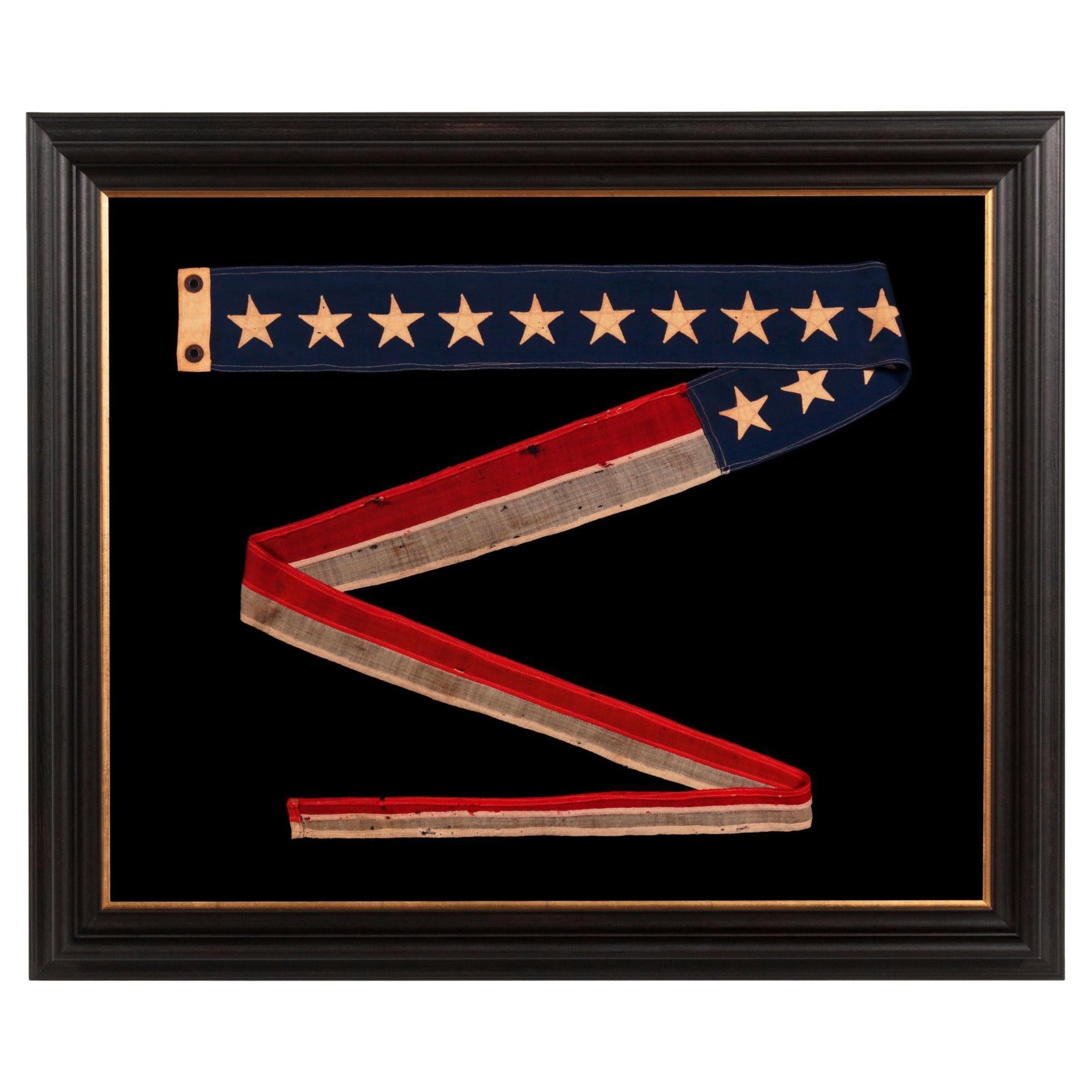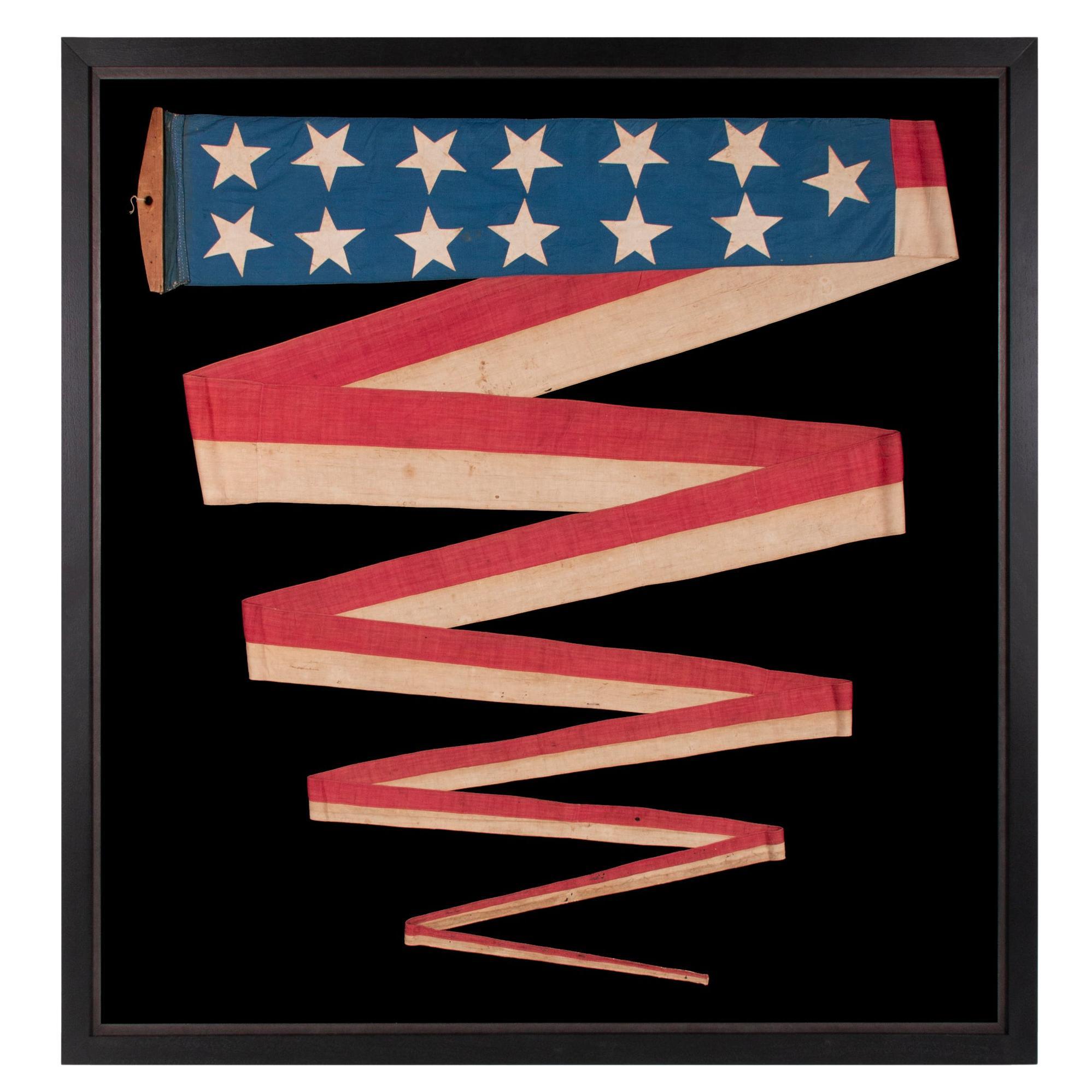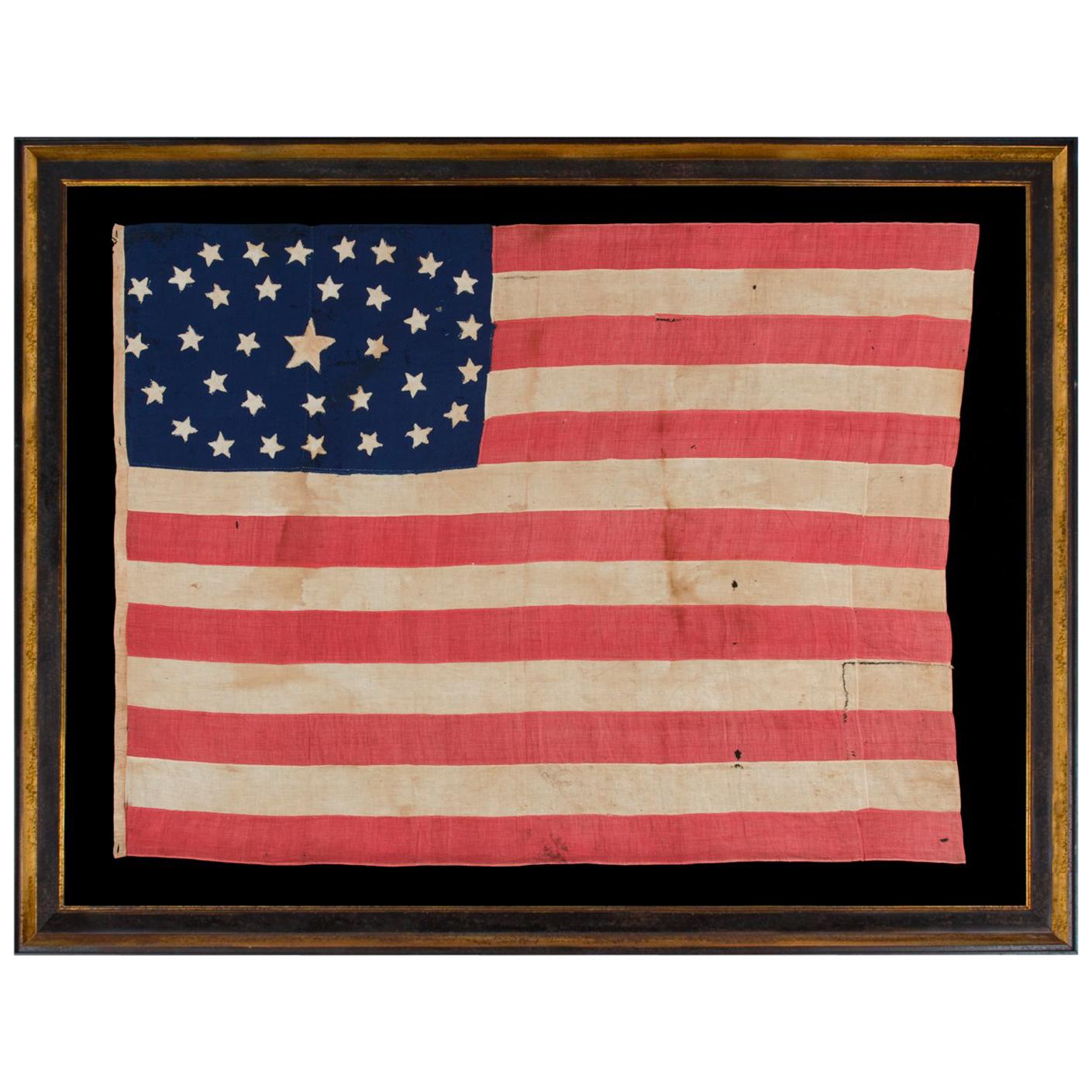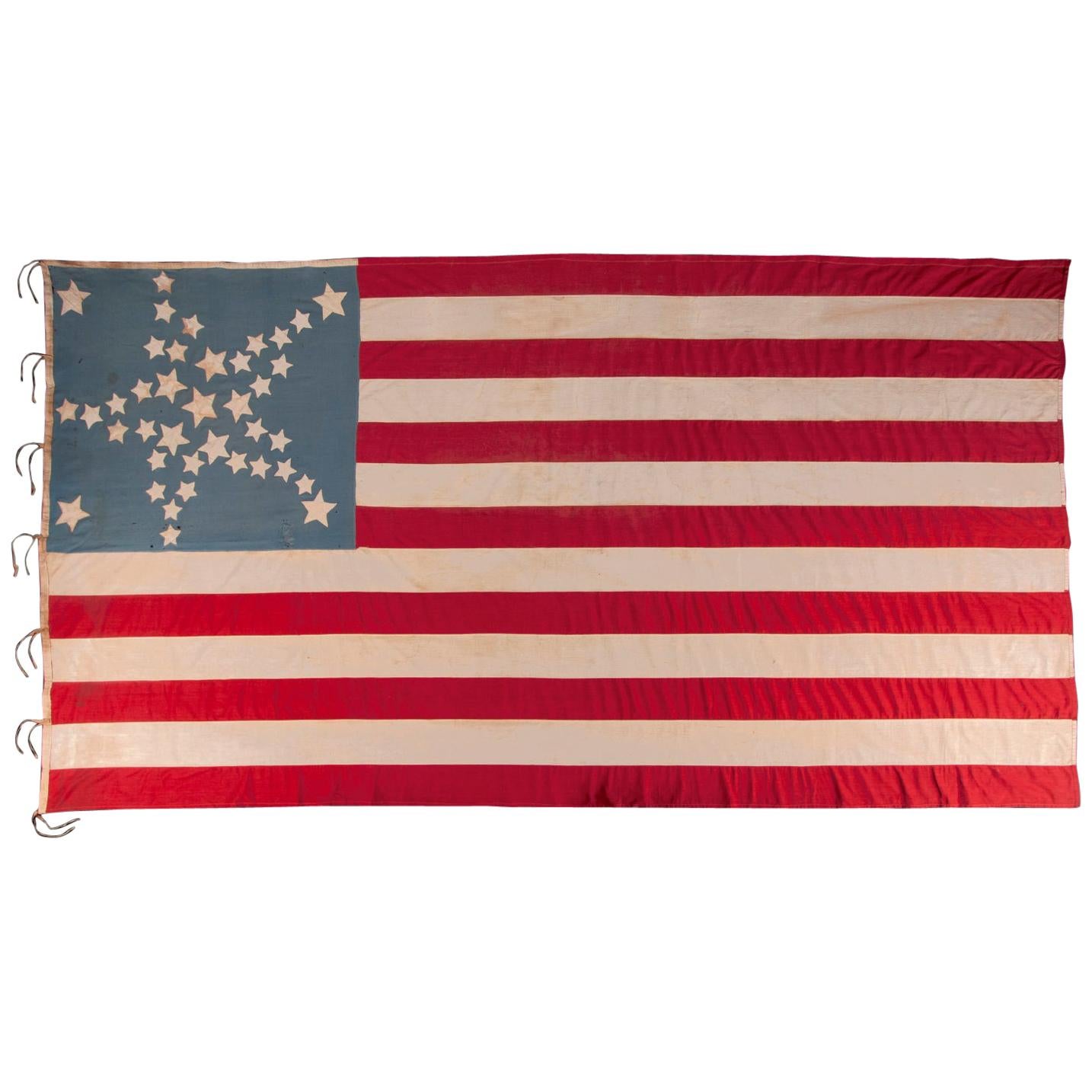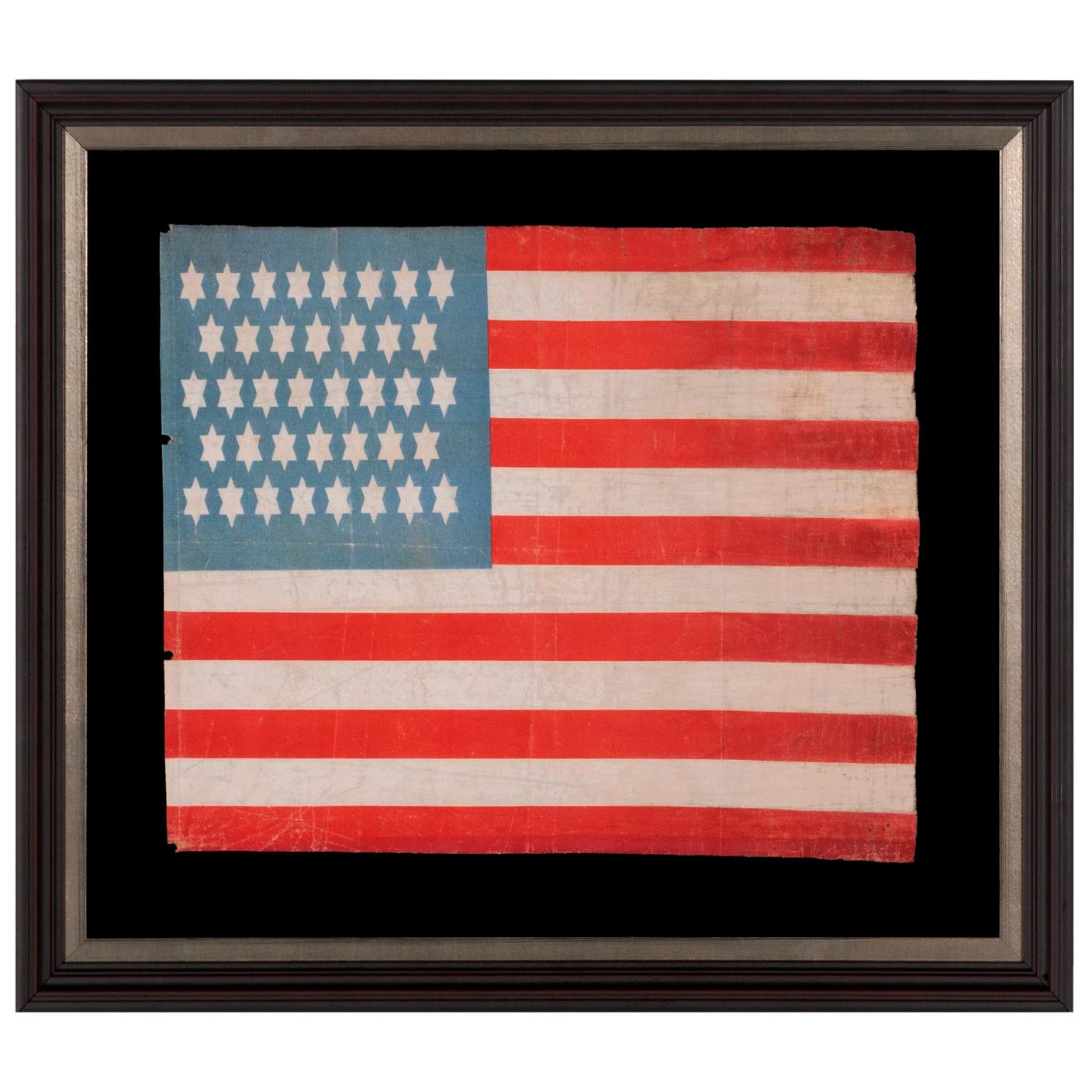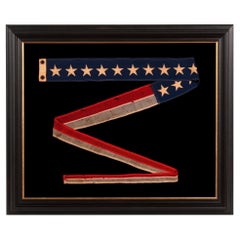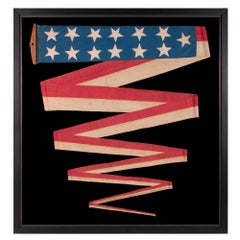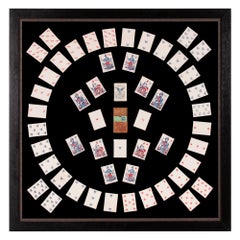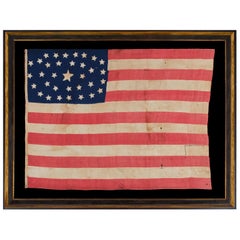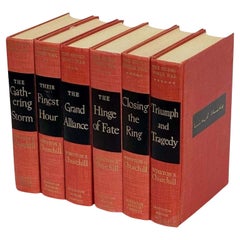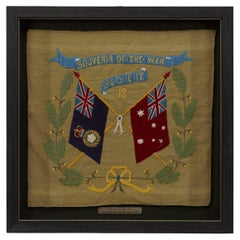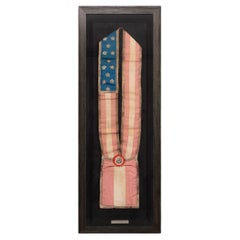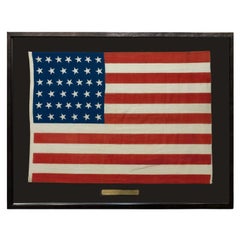Items Similar to U.S War Department Commissioning Pennant with 13 Stars
Want more images or videos?
Request additional images or videos from the seller
1 of 6
U.S War Department Commissioning Pennant with 13 Stars
About the Item
EXTREMELY RARE U.S. WAR DEPARTMENT COMMISSIONING PENNANT WITH 13 STARS, A REVERSAL OF THE U.S. NAVY COLOR SCHEME, TWENTY-FOUR FEET ON THE FLY, SPANISH-AMERICAN WAR - WWI ERA (1898-1917)
By tradition, U.S. Navy ships flew a trio of American flags, including a Stars & Stripes, the Union Jack (not to be confused with the British Union Flag, often identified by this name), and a commission pennant.
Flown off the bow when a ship was at port or anchor, the American Union Jack, often referred to simply as the "jack," was comprised of a blue rectangular field with white stars, exactly like the blue canton of the Stars & Stripes. By Navy regulations, this was to actually be the same size as the canton on the national flag flown by the particular ship.
Flown at the top mast at all times, the United States Navy commission pennant was a long streamer comprised of a narrow blue field with white stars, followed by two stripes, red over white. Hoisted during both times of peace and war, the only time that the commission pennant is not flown is if a flag officer or civilian official is aboard and replaces it with their own.
The pennant in question here is virtually identical the U.S. Navy commission pennant, save that the blue and red colors are reversed, so that it has a red field with white stars, followed by two stripes, blue over white. When I first discovered an example in this style, I came up empty-handed with regards to identification. After more than a year of periodic searching, I resigned to the fact that records of the design simply fell between scant and non-existent. Having exhausted American military references and those of governmental and pseudo-governmental agencies, I had presumed that the pennant must be either yacht club or private steam line-associated. Yacht club commandants sometimes flew similar signals, while Hudson River steamers were sometimes bedecked with all sorts of fanciful, patriotic flags in a host of nautical styles for decorative purposes only. In the end I stumbled across the necessary information while researching an unrelated flag. The similarity between this commission pennant and that of the U.S. Navy turned out to have a perfectly good explanation. This is the commission pennant of the United States Department of War, which administered the Army. The Army operated its own maritime craft to suit various needs better administered within its own service.
Made sometime in the period between the Spanish-American War (1898) and WWI (U.S. involvement 1917-18), the pennant measures 24 feet on the fly. Commissioning pennants were once very important in their role as signals and thus needed to be seen from great distance. During the 18th and 19th centuries, these could reach a hundred feet in length. This was the first thing that would be seen coming over the horizon and, in early America, would aid in the identification of a military vessel. During the 1st quarter of the 20th century commission pennants became largely ceremonial and customary, which is why most Navy examples made in or after WWI range between just four and six feet on the fly.
Early on, commission pennants typically had a number of stars equal to that on the national flag. As more and more states joined the Union, however, it became impractical to use the full complement of stars, especially on smaller examples. During the mid-late 19th century, many substituted 13 stars for the full count, to reflect the original colonies. This mirrored the star count used by the Navy on most of the Stars & Stripes flags that it flew on small craft. "U.S. Navy small boat ensigns," as they are called, most often had 13 stars. In the latter half of the 19th century, the very smallest commission pennants sometimes displayed just 7 stars. Following WWI, all seem to have shared the 7 star count. According to the U.S. Navy, the reason for the choice of 7 stars was not recorded. Smaller War Department pennants also employed this count.
Like many of the 10 - 30 ft. U.S. Navy examples that I have encountered in this period, this War Department pennant displays 13 stars in a single row. The stars are graduated in scale in a very unusual manner. The first 4 are 3" in diameter, followed by 6 at 2.75", then 2 at 2.5", and the last at 2.25". It's not unusual for the first 3 or 4 stars to be larger on an example of this era, but I have never seen the sort of graduated disbursement employed on this pennant.
The body of the pennant is made of wool bunting that has been joined by machine stitching. The stars are made of cotton and are double-appliquéd (applied to both sides) with a zigzag machine stitch. There is a canvas binding along the hoist with a single brass grommet. The fly end of the pennant is forked into swallowtail format.
Unlike the Navy, which has its own, internal command, the War Department was a civilian organization. Founded in 1789, the year of George Washington's first inauguration, its chief official was bestowed with the title, "Secretary of War." The Navy was basically separate from this agency all-together. In 1785, heavily indebted following the Revolutionary War, which ended in 1783, the United States disbanded the Navy and sold its ships to pay debts to France. In 1794, monies were allocated for new ships and in 1798 the Navy and Marine Corps were reformed as their own entities, outside the War Department.
In 1947, just after WWII (U.S. involvement 1941-45), the War Department was split into the Department of the Army and the Department of the Air Force, each becoming it own entity, like the Navy and the Marines. For the sake of a complete explanation of the branches of the military, previous to this time, the U.S. Army Air Corps had served as the primary aviation-oriented entity of the non-Naval military. The Navy maintained its own aircraft, having acquiring its first three planes in 1911. The Coast Guard, founded under the Treasury Department with the title "Revenue Marine" in 1790, enforced customs and protected merchant ships. It received its modern name in 1915 when it merged with the U.S. Lifesaving Service. The Coast Guard remained under the direction of the Treasury until 1967, when it was transferred to the Department of Transportation. During times of war it becomes a service of the Navy.
Mounting: The pennant has been hand-stitched to 100% hemp fabric. It has been folded back-and-forth in a visually interesting zigzag fashion, which simultaneously allows it to be shortened to a manageable scale. The black-painted, hand-gilded and distressed molding is Italian. The glazing is U.V. protective plexiglas.
Condition: There is minor to modest staining in limited areas. There is an approximate 6-inch section of blue wool with a significant tear and associated loss. A length of period wool bunting was placed behind this area during the mounting process for masking purposes.
Frame Size (H x L): Approx. 68.5" x 49"
Flag Size (H x L): 4" x 293" unfurled.
- Dimensions:Height: 68.5 in (173.99 cm)Width: 49 in (124.46 cm)Depth: 2.5 in (6.35 cm)
- Materials and Techniques:
- Place of Origin:
- Period:
- Date of Manufacture:1898-1917
- Condition:See Item Description.
- Seller Location:York County, PA
- Reference Number:Seller: 13j-15801stDibs: LU849718911322
About the Seller
5.0
Recognized Seller
These prestigious sellers are industry leaders and represent the highest echelon for item quality and design.
Established in 1991
1stDibs seller since 2008
69 sales on 1stDibs
Typical response time: 8 hours
- ShippingRetrieving quote...Shipping from: York County, PA
- Return Policy
Authenticity Guarantee
In the unlikely event there’s an issue with an item’s authenticity, contact us within 1 year for a full refund. DetailsMoney-Back Guarantee
If your item is not as described, is damaged in transit, or does not arrive, contact us within 7 days for a full refund. Details24-Hour Cancellation
You have a 24-hour grace period in which to reconsider your purchase, with no questions asked.Vetted Professional Sellers
Our world-class sellers must adhere to strict standards for service and quality, maintaining the integrity of our listings.Price-Match Guarantee
If you find that a seller listed the same item for a lower price elsewhere, we’ll match it.Trusted Global Delivery
Our best-in-class carrier network provides specialized shipping options worldwide, including custom delivery.More From This Seller
View AllCommission Pennant with 13 Stars, like for Private Vessel, Ca 1892-1910
Located in York County, PA
Commission pennants are the distinguishing mark of a commissioned U.S. Navy ship. Flown at the topmast, the typical American format is a long blue field, usually with a single row of white stars, although sometimes with their total divided into two rows, followed by two long stripes, red-over-white. A ship became commissioned when this pennant was hoisted. Flown during both times of peace and war, the only time the pennant is not flown is if a flag officer or civilian official was aboard and replaced it with their own flag.
Sometimes the owners of private ships mimicked the use of Navy signals. Some seafaring men would have served in the Navy and become privy to various practices in that capacity. Others flew them purely for stylistic reasons, either on a regular basis or while the boat was dressed for special occasion. Hudson River steamers regularly flew pennants of this nature, as evidenced by period photography as well as the paintings of artists such as John and James Bard...
Category
Antique Late 19th Century American Political and Patriotic Memorabilia
Materials
Wool
Price Upon Request
Hand-Sewn 13 Star Cornflower Blue 32 Foot Commission Pennant circa 1845-1865
Located in York County, PA
ENTIRELY HAND-SEWN, 32-FOOT, SHIP’S COMMISSION PENNANT OF THE 1845-1865 ERA, A HOMEMADE, COTTON EXAMPLE, WITH 13 STARS ON A CORNFLOWER BLUE CANTON, IN A BEAUTIFUL STATE OF PRESERVATION
Commission pennants are the distinguishing mark of a commissioned U.S. Navy ship. A ship becomes commissioned when the pennant is hoisted. Flown during both times of peace and war, the only time it is not flown is if a flag officer or civilian official is aboard and replaces it with their own flag. Flown at the topmast, this would be the first thing one would see coming over the horizon and identified the vessel as a warship.
Sometimes the owners of private ships mimicked the use of Navy signals. Some seafaring men would have served in the Navy and become privy to various practices in that capacity. Others flew them purely for stylistic reasons, either on a regular basis or while the boat was dressed for special occasion. Hudson River steamers regularly flew pennants of this nature, as evidenced by period photography as well as the paintings of artists such as John and James Bard...
Category
Antique Mid-19th Century American Political and Patriotic Memorabilia
Materials
Cotton
1862 Civil War Playing Cards with Stars, Flag, Sheilds and Eagles
Located in York County, PA
1862 Civil War playing cards with stars, flags, shields, & eagles, and face cards illustrating civil war officers and lady, Columbia, ca 1862, Benjamin Hitchcock, New York
1862 Civil War playing cards with suits represented by stars, flags, shields, & eagles, in lieu of the traditional French suits of hearts, diamonds, clubs, and spades. The face cards feature Union Army officers and Lady Columbia [a.k.a. Lady Liberty, Goddess of Liberty]. Entitled “Union Playing Cards,” two versions of this deck were produced in New York by Benjamin W. Hitchcock’s “American Card Company.” This is the earlier of the two. The other was released in 1863.
There are 52 cards in total with the ace of spades doubling as the title card, as was often the case during the 19th century. The telescoping box...
Category
Antique 1860s American Political and Patriotic Memorabilia
Materials
Paper
Price Upon Request
34 Stars in an Outstanding Oval Medallion Configuration, Civil War Period
Located in York County, PA
34 STARS IN AN OUTSTANDING OVAL MEDALLION CONFIGURATION, ON A NARROW CANTON THAT RESTS ON THE 6TH STRIPE, ON A HOMEMADE, ANTIQUE AMERICAN FLAG OF THE CIVIL WAR PERIOD, ENTIRELY HAND-...
Category
Antique 1860s American Political and Patriotic Memorabilia
Materials
Cotton
34 Star American flag, Updated to 39 Stars, with Stars in a Great Star Pattern
Located in York County, PA
34 STARS IN A WHIMSICAL RENDITION OF THE GREAT STAR PATTERN, ON A CIVIL WAR PERIOD FLAG WITH A CORNFLOWER BLUE CANTON, UPDATED TO 39 STARS IN 1876
34 star American national flag with additional stars added and one of the most stunning graphic designs I have ever seen in early flag-making. The original pattern was comprised of a circle of 5 large stars, and triangular arms made of smaller stars. These are noticeable pointy and bent like the arms of a starfish. Made of cotton, the stars are hand-sewn and double-appliquéd to a fantastic, cornflower blue canton, a color common to Civil War uniforms...
Category
Antique 1870s American Political and Patriotic Memorabilia
Materials
Cotton
Price Upon Request
Free Shipping
38 Star Parade Flag with Whimsical 6-Pointed Stars, Colorado Statehood
Located in York County, PA
38 WHIMSICAL STARS, WITH 6-POINTED PROFILES, SIMILAR TO THE STAR OF DAVID, ON AN ANTIQUE AMERICAN FLAG OF THE CENTENNIAL ERA; A REMARKABLE SPECIMEN, ONE-OF-A-KIND AMONG KNOWN EXAMPLE...
Category
Antique Late 19th Century American Political and Patriotic Memorabilia
Materials
Cotton
Price Upon Request
You May Also Like
"The Second World War, " by Winston Churchill
By Houghton Mifflin & Co.
Located in Austin, TX
The Second World War by Winston Churchill from Houghton-Mifflin Company, Boston.
A vintage edition of Winston Churchill's six-volume memoir, The Second World War, for which he was a...
Category
Mid-20th Century American Modern Books
Materials
Paper
Souvenir of the War 1914-15-16-17-18 Banner
Located in Colorado Springs, CO
Presented is a stunning textile banner from the first World War, dating to 1918. The square tan cotton cloth is embroidered with two crossed flags, the ...
Category
Vintage 1910s Australian Political and Patriotic Memorabilia
Materials
Cotton
Antique 13-Star Patriotic Sash by Louis E. Stilz & Bros., Late 19th Century
Located in Colorado Springs, CO
Presented is an original patriotic sash from the late 19th century, featuring 13 stars against a bright blue field. This sash features appliqued silver stars on a blue canton, red an...
Category
Antique Late 19th Century American Historical Memorabilia
Materials
Cotton
39-Star Antique American Flag with 'Whimsical' Star Pattern, 1889
Located in Colorado Springs, CO
This is a 39-star unofficial American flag, handmade and printed on cotton. The flag dates to 1889 and has a unique history, thanks to its rare star-count.
The flag’s canton is prin...
Category
Antique 1880s American Political and Patriotic Memorabilia
Materials
Cotton
William & Mary Rare Pewter Trefid Spoon with Portraits, Circa 1690
Located in Bishop's Stortford, Hertfordshire
Very rare William and Mary pewter trefid spoon the handle molded in relief with portraits and dating from around 1690. The spoon has an elongated rounded ...
Category
Antique 17th Century English William and Mary Political and Patriotic Me...
Materials
Pewter
38-Star Antique American Flag with Unique Canton, circa 1876-1890
Located in Colorado Springs, CO
This is a striking 38-star American flag. The flag dates to 1876-1890, when Colorado (represented by the large star in the center of the flag’s canton) joined the Union as the 38th s...
Category
Antique Late 19th Century American Political and Patriotic Memorabilia
Materials
Muslin
Recently Viewed
View AllMore Ways To Browse
Commissioned Mirror
Vintage American Memorabilia
U S Flag
Service Flag
Rare Black Memorabilia
Small American Flag
Navy Flags
Folk Art Applique
Rare American Flag
Blue And White Transfer
Italy Flag Vintage
Vintage 19th Century Mirror
Black And White Painted 19th Century Italian
Vintage Union National Furniture
Army And Navy
Wool Flag
Plane Mirror
Union Jack Flag
